“Cow Hocks” is a common postural deviation found in canines, resulting from a muscle imbalance between the internal and external hip rotators, also known as the medial and lateral hip rotators, respectively. These small muscles are local stabilizers located near the bone and are responsible for the positioning of the femoral head in the hip socket.
When the external hip rotators exert excessive pull while the internal rotators don’t pull enough, it results in a Cow Hock posture.

Cow Hock postural deviation can manifest to a greater or lesser degree between individuals. This can be seen in the photos above. You’ll notice some of these dogs externally rotate more significantly than others, which indicates a more significant muscle imbalance. When this happens in the front limbs it is called “East-West” deviation.

Cow Hock postural deviation can also be seen here in the Sit, Down, and Stand position.
Why is it important to correct Cow Hock postural deviation in dogs? Here are some significant reasons:
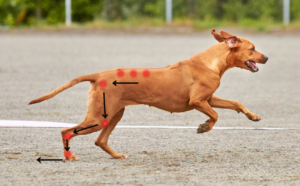
1. Joint Stability: Proper alignment of the hip and stifle joints is crucial for maintaining joint stability. When these joints are correctly aligned, the bones, ligaments, tendons, and muscles work together efficiently to support the dog’s body weight and withstand forces during movement. This stability reduces the risk of joint injuries, excessive wear and tear, and the development of conditions such as ligament injuries, meniscus damage, or patellar tendonitis.
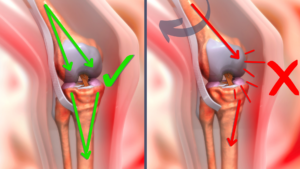
2. Load Distribution: Correct alignment of the hip and stifle joints ensures even distribution of forces and load-bearing capacity throughout the hind limbs. When the joints are properly aligned, the weight and impact forces generated during activities like walking, running, turning, or jumping are evenly distributed across the joint surfaces and surrounding structures. This balanced distribution helps prevent excessive stress on specific areas, minimizing the risk of cartilage degeneration, osteoarthritis, and other joint-related issues. Allowing cow hock posture to continue unchecked can result in uneven cartilage wear in the hip and stifle, the development of osteophytes (bone spurs), and other secondary injuries in adjacent joints.
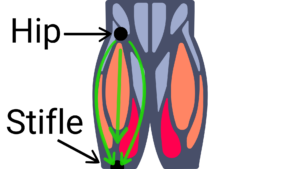
3. Muscle Function and Efficiency: Proper alignment of the hip and stifle allows the muscles surrounding these joints to function optimally. When the joints are in alignment, muscles can generate and transmit forces effectively, supporting movement, and maintaining joint stability. This optimal muscle function helps prevent muscle imbalances, overuse injuries, and inefficient movement patterns. Conversely, Cow Hock posture places excessive strain on the muscles and soft tissues involved in acceleration, deceleration, and turning, increasing the risk of injury to those tissues.

4. Kinetic Chain Alignment: The body is a system where everything works together. The hip and stifle joints are part of a larger kinetic chain that includes other joints like the hock, foot, and spine. Proper alignment through the hip and stifle is essential for maintaining the overall alignment and function of these kinetic chains. Misalignment at the hip or stifle can have a cascading effect on other joints, leading to compensatory movements, increased stress on adjacent joints, and potential injury.
5. Reducing Injury Risk: This is perhaps the most important reason why addressing Cow Hock posture is crucial. Correct alignment of the hip and stifle joints plays a significant role in reducing the risk of injury. When the joints are properly aligned, the body can absorb and distribute external forces more effectively, reducing the risk of acute injuries such as sprains or strains. Additionally, proper alignment helps mitigate the impact of repetitive stress and overuse, lowering the likelihood of developing chronic overuse injuries like tendonitis or stress fractures. On the other hand, Cow Hock posture exposes the medial meniscus, medial aspect of the patellar tendon, CCL, and the deep and superficial digital flexors that attach to digit two to increased forces due to how external hip rotation affects pelvic limb alignment.
6. Function and Performance: Optimal alignment through the hip and stifle joints is essential for functional activities and athletic performance. Whether it’s walking, running, jumping, or participating in dog sports, proper alignment enhances biomechanical efficiency, power generation, and movement control. It can improve agility, balance, and overall performance while reducing the risk of performance-limiting factors or compensatory movements.
“But Cow Hocks improve turning speed!”
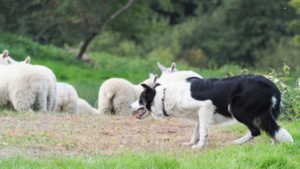
This is one of those myths that makes me scratch my head and seems to confuse correlation and causation. External hip rotation can play a role in a dog’s ability to move laterally, but it is just one of many factors involved. Lateral movement involves the ability to shift weight and change direction efficiently, which requires coordinated movement and stability in multiple joints and muscle chains.
However, it’s important to note that the ability to move laterally is not solely dependent on external hip rotation. Other factors, such as hip abduction/adduction, stifle and hock stability, core strength, balance, proprioceptive speed, and coordination, also play significant roles. Additionally, the overall functional movement patterns, sport-specific requirements, and individual biomechanics of the athlete need to be considered.
As we have established above, proper joint alignment, joint stability, ideal load distribution, kinetic chain recruitment, and improved function and performance result from neutral alignment of the pelvic limb and balanced muscle development. Therefore, it follows that deviation from neutral as a default state simply cannot result in improved functionality over the course of a lifetime. Moreover, we know that muscle imbalance is the number one predictor of injury in humans and canines. Therefore, promoting muscle balance is critical to reducing the risk of injury.
It’s worth mentioning that individual dogs may have variations in their natural hip range of motion, alignment, and biomechanics. However, the goal should always be to move toward functional neutral alignment rather than promoting excessive Cow Hock alignment.
So how do we correct Cow Hock alignment?
The way to address Cow Hocks is to correct this muscle imbalance through targeted exercise, strengthening the internal hip rotators, and lengthening the external hip rotators. Because these muscles are postural muscles, the most effective way to do this is by practicing proper posture. To fully retrain this postural deviation, we will have to retrain the muscle imbalance along with training the mind to select the correct/new muscle. And this is how.

First, my favorite exercise to start with is the Adducted Stand- PL Focus exercise. In this exercise, both rear feet are targeting a single PawPod. In order to fit both rear feet on a single PawPod, the dog has to engage the weak internal hip rotators, and disengage the external hip rotators that cause the Cow Hock alignment. This sets the dog up for errorless learning, and gives us a chance to target and reward that specific muscle engagement, building endurance over time.
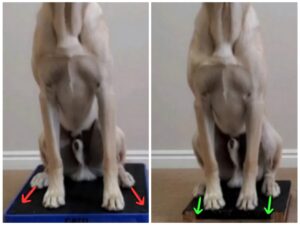
The next static exercise to implement is the Posture Sit Exercise. In this exercise, the dog has to consciously choose to select the internal hip rotators and deselect the external hip rotators to move out of the Cow Hock position. In the Adducted Stand exercise mentioned above, the dog did not have a variety of options to choose from. There was only one option. Now that the dog’s brain and body are primed to select the internal hip rotators, we can allow for choice, and mark and reward when the dog chooses to adjust into the correct position.
I use a body motion/handler motion cue in the Posture Sit video, coupled with marking and rewarding. This creates a powerful tool we can use in all the following exercises to help our dog move out of the Cow Hock posture if they make a mistake and into the correct alignment. Please don’t skip this step!
Once we build endurance in a static position, then we can transition to a semi-dynamic movement pattern. Remember, not only are we retraining the muscle engagement to correct the Cow Hock posture, but we also have to retrain the neuromuscular connection where the brain SELECTS which muscles are going to work in a given situation. So it’s mind + body. If we introduce a movement pattern that is too complex, too fast, or too difficult, the dog will simply revert to the Cow Hock posture, and we will be undoing all our hard work.

A good semi-dynamic movement pattern to transition to next is the Sit-Walk Forward Down exercise. In this exercise, the dog is tasked with maintaining a Square Sit Position, transitioning into a Down, and then back up into a Sit. We ensure the dog is sitting squarely and not falling back into their old Cow Hock muscle recruitment pattern by using a platform narrow enough to help promote parallel hock alignment. Measuring guidelines can be found in my “Measuring for Platforms” blog post.
You’ll notice that this is a semi-dynamic exercise because the area being targeted is actually staying still, while the dog’s forehand is moving. This keeps things simple and ensures the dog is likely to select the correct movement mechanics vs. the faulty Cow Hock movement mechanics.
Remember, you can and should integrate the handler motion cue we used in the Posture Sit Exercise into all sitting exercises. This will help your pup adjust into proper alignment if they forget. And if your pup starts to make more than 2 mistakes in a row, that is an indication of fatigue, NOT disobedience.

Lastly, we can transition to a fully dynamic movement pattern like the Fold Back Down. Keep in mind that the concentric phase (where the dog is pushing up into gravity) will always develop before the eccentric phase (where the dog is slowly resisting gravity). So in the beginning, focus on the alignment from the down transitioning back up into the stand, using your handler motion posture adjustment as needed. Once your pup is executing with no Cow Hock alignment (parallel hocks) 85% of the time, you can start to focus on the eccentric phase.
All of these exercises target the internal hip rotators, and ask the dog to execute proper pelvic limb alignment. We start with exercises that are static to give our pup’s the best chance of recruiting these weak and hard to recruit muscles (high threshold for innervation). Then, once they have demonstrated proficiency in a static exercise, it is fair to transition to a semi-dynamic exercise, where the rear limbs stay still while the front legs move. This acts like a bridge, giving the pup the best chance of being successful. Lastly we can transition to a fully dynamic exercise, where alignment has to be maintained while the pelvic limbs move through a coordinated range.
Remember, splitting is better than lumping when trying to address deeply engrained postural deviations.
Summary:
- Cow Hocks are the result of a muscle imbalance between the internal and external hip rotators.
- Correcting Cow Hocks ensures proper mechanics through the pelvic limb and reduces the risk of repetitive overuse-type injuries, ensures forces are transmitted properly through the hip, stifle, hock, and foot, and sets the dog up for powerful, explosive, and efficient movement.
- The idea that Cow Hocks improve turning ability is overly simplistic and does not take into consideration the negative impacts of postural deviation.
- To correct Cow Hock alignment, we have to train the body and brain to select the internal hip rotators more than the external hip rotators.
- This requires static posture, semi-dynamic, then dynamic movement patterns. Progressing too quickly will likely result in regression.
- Try the following exercises in order:
Have a question? Or a story to share about your pup with Cow Hock posture? Drop me a comment below!


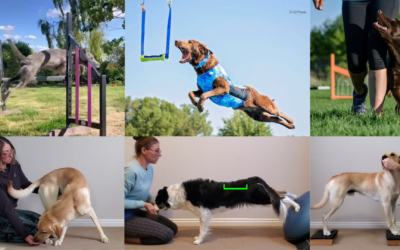
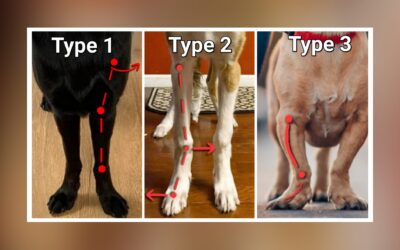
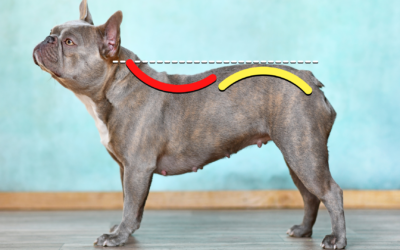
Im trying to plan out platforms before purchasing the sloppy sitter program, but am having a hard time visualizing what I’m supposed to look for when sizing the wood. In the photo of the correct posture sit above it looks like the dog’s right paw is over the edge of the platform. Is it okay if my dog’s paw sits over the edge when we go to Lowe’s for wood? I tried to find the answer in other posts but I couldn’t. Thanks for your help.
Hey Alayna! That’s a great question!
Have you seen the blog post dedicated to Measuring for Platforms ?
I think that will do a better job answering your question than I can do here. The write up is pretty extensive, and includes several images that I think will help provide clarity.